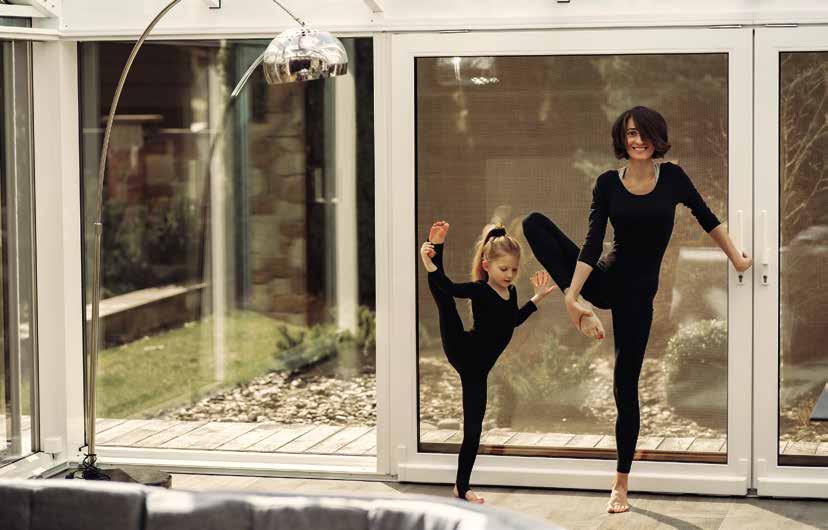
15 minute read
EYE CARE FOR KIDS
Eye Care for Kids A Clear Path to Healthy Vision
The blurry distant vision of myopia is a worldwide epidemic. Nearsightedness has doubled in the U.S. since 1971 to 42 percent, and in some Asian countries it affects 90 percent of teens and adults, reports the American Academy of Ophthalmology. Eye doctors say the key time to pay attention is during childhood, because myopia and other eye and vision problems can be reversed or stabilized if addressed at an early age.
Advertisement
“Parents tend to assume that vision problems aren’t a concern for the young and healthy, but it’s never too early to promote healthful habits or to be on the lookout for potential vision issues,” advises ophthalmologist Sandy T. Feldman, M.D., medical director of the Clearview Eye & Laser Medical Center, in San Diego.
Ophthalmologists and optometrists recommend having a child’s eyes tested at 6 months, 3 years and 5 or 6 years to detect nearsightedness, farsightedness, astigmatism, “lazy eye” (amblyopia), crossed or misaligned eyes (strabismus) and other potential problems. “For signs of trouble, I ask parents if they have seen their child have an eye that wanders or if the child covers an eye regularly, they are rubbing their eyes or playing with their by Ronica A. O’Hara toys close to their face,” says optometrist Nathan Langemo, of the Hopkins Eye Clinic, in Hopkins, Minnesota.
If myopia becomes severe, it can lead to retinal detachment, premature cataracts and glaucoma in adulthood, but early detection is possible. An Ohio State University study of 4,500 children found that myopia in eighth-graders could be predicted in the first grade by their eyeglass prescription. Children at age 6 are naturally slightly farsighted, and those with normal vision are more likely to become myopic later.
A common medical treatment to slow myopia in kids is daily use of 0.01 percent atropine eye drops, the medication used to dilate an eye before an exam. It slowed down nearsightedness by roughly 50 percent in Singapore children. A new, twoyear study shows that combining the eye drops with nightly contact lens-wearing is 28 to 38 percent more effective. For preschoolers with amblyopia, an iPad game called Dig Rush was shown to be helpful in a University of Texas Southwestern Medical Center study. Hong Kong researchers report that 15 weeks of acupuncture beat out eye patches for treating children with lazy eyes, resolving the condition in 41 percent of cases, compared to 16 percent.
The simplest preventive strategy for myopia may be simply to shoo children outdoors every day, including involving them in outdoor sports. Researchers aren’t sure whether it’s the vitamin D effect or the fact that when they are outdoors kids focus more on distant objects like trees and balls than when reading a book or screen, but recent studies in Taiwan and Denmark have verified that more time outdoors is linked to less myopia. Even sitting in sunlight inside while reading or using full-spectrum light bulbs is protective, say researchers. When outdoors, “Make sure the child has 100 percent UVA and UVB sun protection for the eyes,” advises Langemo, including using UV contact lenses.
Evidence is mixed on whether closeup reading brings on childhood myopia, but a study of 500 college students that heavily used computers found 53 percent reporting headaches, 55 percent with burning sensations in the eyes and 48 percent with tired eyes. When kids focus on a computer, their eye-refreshing blinking rate slows from 10 to 12 times a minute to three or four times a minute, says optometrist Marc Grossman, of New Paltz, New York, author of Natural Eye Care: Your Guide To Healthy Vision and Healing.
He recommends taking breaks at least 10 minutes every hour, using homeopathic eye drops and gently massaging the eyes by moving fingers from the inner corner, around the upper socket and underneath, stopping about six times to massage each point for five to 10 seconds.
It’s also important to remove household hazards. Medical emergency rooms increasingly report eye injuries in kids from popular toy weapons like Nerf, BB guns and paintball guns, as well as colorful detergent pods that preschoolers love to squeeze or bite, plus aerosol spray from paint, hairspray, cleaning products and bug repellants.
Feeding children the right foods, including lots of vegetables, fruits and grains, also benefits their eyes. The omega-3s in fish oil, nuts and seeds help minimize dry eye, and leafy greens and eggs have the eye-protective antioxidants lutein and zeaxanthin.
SUPPORT YOUR IMMUNE SYSTEM:

Five Must-Have Photo by PhotoMIX Ltd. from Pexels
Immune Support Agents
by the team at Quantum Nutrition Labs
Toxins in the environment can wreak havoc on our health. Scientific studies demonstrate that the average person receives approximately 100,000 oxidative hits to their DNA (per cell) every single day. Over time, that adds up to a lot of bio-stressors that our cells are exposed to, day in and day out. Typical environmental stressors include pollution, unsafe food production, and global electromagnetic technology. Being constantly exposed to these toxins can threaten the body’s immune health.
In times of environmental stress, supporting the body’s immune system is critical. And there’s no better place to look than nature to provide comprehensive immune support. The natural world is filled with immune supporting botanicals that can recharge the immune system and boost the body’s natural defenses against environmental toxins.
Here are five of the most beneficial immune support agents provided by Mother Nature. 1 Nucleotides: A Repair Master Nucleotides are the basic building blocks of every cell in the body. It takes six billion nucleotides to build one single cell. When we are healthy, our bodies store nucleotides for future use. After infection, surgery or trauma, the body uses these stores to repair cells. When we are stressed, these nucleotide stores are exhausted, leaving the body struggling to keep up with cellular repair. Supporting the body with supplemental nucleotides can also promote healthy protein synthesis, energy production, and immune system health. Cells can use these fresh nucleotides to support a healthy immune system response.
2Garlic: Stinky but Awesome Although we might think of garlic as just a delicious addition to meals, this herb has a sterling reputation for use in natural healing. When raw garlic is crushed or chewed, the compound alliinase is naturally released. This alliinase enzyme then helps convert alliin to allicin, which happens to be an incredible immune support compound.
Allicin is the stellar compound that gives garlic extract its incredible, broad-spectrum immune support. This compound supplies antioxidants and can even help reduce inflammation. Consuming a high-quality garlic supplement may be an excellent way to help ward off a broad range of pesky illnesses. 3 Vitamin C: Choose Natural Sources Only One of the most well-known immune support agents, natural vitamin C, supplies substantial antioxidant support to the body. This critical vitamin helps to manage a healthy inflammatory response and facilitates neurotransmitter formation.
Unfortunately, many vitamin C products contain only “dead” chemicalized ascorbic acid powder. With that in mind, it is imperative to seek out naturally sourced vitamin C which contains a wide array of phytonutrients including tannins, flavonoids and polyphenolic compounds. Natural-sourced vitamin C can boost blood antioxidant levels, help the body fight free radicals, support cellular health and wellness, and even shorten the length of respiratory and systemic infections.
An ideal vitamin C supplement would feature full-spectrum vitamin C concentrates from potent plants, such as amla, a highly revered nutritional Ayurvedic fruit. 4 Zinc: A Small but Mighty Mineral A lesser-known support agent, zinc, plays a significant role in immune health. A deficiency in zinc can cause immune dysfunction and an interruption to immune function. Zinc facilitates communication with ligands, which then bind to immune cells and play a key role in complex cell signaling. Researchers estimate that about one-third of the world’s population is zinc deficient. That means that lowered immune function due to zinc deficiency is common.
Zinc is a critical micronutrient, but many supplements on the market are formulated using poor sources of zinc such as zinc oxide or zinc carbonate. Due to their minimal ionic charge, these forms are poorly absorbed in the body. When supplementing with zinc, look for a formula that provides a superior zinc form such as zinc sulfate heptahydrate, an easily absorbable, hydrated form of zinc sulfate. 5 Fermented Mushrooms:
Treasured Immune Powerhouses
Medicinal mushrooms have been a treasured part of Eastern diets for centuries as they are shown to support immune function
by providing robust phytonutrients, called polysaccharides. These special, naturally occurring agents promote the activation of the immune system—which means a big boost to immune health and overall wellness. Studies have shown that a combination of maitake, shitake and/or reishi mushrooms significantly improved immune system function by increasing natural killer cell activity.
One of the best ways to consume mushrooms is by taking a fermented mushroom powder. Fermentation easily boosts the mushroom’s natural immune compounds, making them easier to digest. In addition, releasing the mushroom’s nutritional payload through fermentation breaks down the chitin in the mushrooms’ cell walls and provides postbiotic metabolites to further support immune health.
The Bottom Line
Adopting a comprehensive nutritional program, including immune-supporting botanical agents, is one of best ways to support the immune system from daily environmental invaders. There is no better time than now to start!
Quantum Nutrition Labs partners with industry leaders in botany, microbiology, and laboratory analysis to produce clean products that are rigorously screened for purity, identification, and contaminants. They are one of six companies in the United States to be awarded the prestigious USP GMP-Certified Program. More information at QNLabs.com. See ad on this page.
SPONSORED CONTENT
Whether you’ve been searching for integrative, holistic medicine for allergies or just beginning to seek relief, you’ve come to the right place! CALL TODAY OR GO ONLINE
TO SCHEDULE YOUR
APPOINTMENT 3365 N. ARLINGTON HTS. RD., SUITE D, ARLINGTON HEIGHTS
Non-Invasive Testing can treat over 400,000 di erent items. Safe, E ective and Gentle Enough for Infants to Seniors Spring into Symptom-Free Living with May Special $10 o .
WE ALSO ACCEPT HSA & FSA ACCOUNTS. Holistic Allergy Treatment Services ✸ Non-invasive testing to fi nd the exact components causing your reaction ✸ Customized treatment plans for allergies and food sensitivities and stimuli such as barometric pressure, motion sickness, humidity, EMFs, personal care items, pets, outdoor allergies and more… ✸ Quality results without nagging symptoms




847-392-7901 MidwestAllergyRelief.com

Holistic Self -Care During a Crisis

by Carrie Jackson
Unprecedented. Challenging. Pandemic. Crisis. However you hear it described, it’s true that we are universally facing a time of change and uncertainty which can trigger feelings such as anxiety and fear. With procedures and precautions rapidly shifting, it’s more important than ever to cultivate peace within and practice radical self-care. We asked leading holistic professionals in our area to share their favorite tools for taking care of ourselves during this crisis.
Cultivate Calm and Health at Home with Feng Shui
“As we shelter in place, there are two areas of the home according to Feng Shui guidelines that can help remain calm and stay healthy. The area on the front, right side of your home, known as the Helpful People area, brings Helpful People into your life, but also relates to the head. So, during a time of anxiety, tension, and fear, this is the place to create a peaceful, calming feeling. Add a fountain, play music with sounds of calming water or waves, sit and meditate, or simply draw a picture of a big smile face looking right back at you. The second area is in the Center of your home, the Health area, and is a perfect place to create balance. Grab a blanket, gather the family, dogs, cats and sit in the center of your home. Children and animals are especially aware of vibrational energy and will love being included! Begin clapping to raise the energy. Smiles and laughter will erupt as you clap faster and faster. Then, ask everyone to quietly place their hands in prayer position in front of their hearts. Take a deep breath, close the eyes, and release the breath as you say a long and loud ‘Ohhhhmmm.’ ” Repeat a few times to raise the energy and create good health! - Laurie Pawli, director of the Feng Shui School of Chicago (TheFengShuiSchoolOfChicago.com)
Meditate to Calm the Mind
“Peace of mind is priceless, especially now when our life and world are so uncertain, and it can be enhanced and stabilized with regular meditation practice. Take two to 10 minutes to focus steadily on the sensation of your breathing—or until your mind calms down a bit—and then deeply enjoy your own peace of mind, no matter how small it may feel. This is not a luxury, but a reliable, effective protection from difficult emotions and negative thinking, and an authentic foundation for genuine kindness, patience and empathy. Then, in daily life, instead of dwelling on the waves of difficult emotions or negative thinking you may experience, recall and reconnect to the feeling of peace from meditation and anchor your mind to it. With practice, your mind can remain calm no matter how difficult life becomes.” - Gen Kelsang Zamlin, Buddhist monk and resident teacher at Kadampa Meditation Center Chicago (MeditateInChicago.org)
Listen to Your Body
“Everyone always has a healing impulse at work in their body, all the time. To access it, just ask yourself, ‘Where is there a place in my body that feels great?’ And see what part of your body captures your attention. Try to describe for yourself the way that part of your body feels. Breathe deeply into
your whole body, but especially breathe into the area that feels good. As you exhale, allow the good feeling to travel through your body, like the breath carries it along to the rest of your body. Keep breathing into that feeling and help it spread for a few minutes, at least 10 to 20 breaths in and out.” - Steve Rogne, director, Zen Chicago (ZenShiatsuChicago.org)
Organize Your Home Space
“Organizing reconnects you with your home and gives a feeling of control over your life at a time when things might feel out of control. Our homes are working hard for us right now. When we leave them for limited reasons right now, we can return to them with a sense of gratitude. Take 20 seconds as you return to thank your home, out loud or in your head. Identify a few keywords to describe how you want to feel in your space right now, and use them as a guide as you make any decisions about what to keep in your space. Tackle small projects, like a junk drawer that overflows, a cabinet that doesn’t close properly or a linen closet that could use some attention. Empty these spaces, set a timer and get to work by grouping like items with each other. You may find some items need to be relocated or you are ready to let go of them. Since donation centers are closed, putting them aside in a car trunk or garage might be an option. Whatever you end up doing, keep gratitude and joy for what we do have at the center of your thoughts, and enjoy whatever it is in your space that makes it special to you.” - Megan Spillman, professional organizer and founder of Peace & Tidy (PeaceAndTidy.com)
Enhance Wellness in Body, Mind and Spirit
“Anything that is unfamiliar, out of place or presents a discrepancy will trigger our autonomic nervous system to start producing stress hormones and adrenaline. It is possible to mindfully neutralize the impact of our body’s natural defense system. Let yourself sink into this moment, taking a break from thinking about anything in particular, for 20 to 30 seconds, and then notice how your body feels inside. Pause every once in a while, several times a day, and relax into the moment. Stop and gently take notice of something beautiful—something you love to look at in your house like a photo, a candle or art object, or curl up with a blanket, hang out with a pet, or gaze out the window and take in the contours of a branch, a cloud or even a patch of grass outside your window. Take breaks to slowly stretch your neck, shoulders or your whole body. Avoid ‘futurizing’, which is our main source of anxiety. Remind yourself that your brilliant, resilient and resourceful mind will be there to handle the future—in the future! Let go, for now.” - Ellen Katz, MS, LMFT, clinical director, Inner Balance (InnerBalanceNow.com)
Stay Engaged and Fulfilled
“In times of uncertainty, refresh yourself regularly with humor, laughter, and silliness. Practice smiling throughout the day. It truly is good for you in many ways! If you need some lighthearted resources try searching Whose Line is it Anyway or John Krasinski’s Some Good News on YouTube. Play charades with a friend on your favorite video chat platform. Leave kind notes for your neighbors. Write a note to at least one adult and one child each day. It can be one line, it does not have to be fancy or eloquent. You can share an old photo, something you appreciate about them or that makes you think of them. Remember how great it feels to get a real handwritten note in the mail.” - Sarah Karnes, life changes coach (SarahDKarnes.com)
Carrie Jackson is an Evanston- based writer and frequent co ntributor to Natural Awakenings magazine. Connect at CarrieJacksonWrites.com. Fo r more information about the resources in this article, see their websites as well as ads in this magazine, in the Com
munity Resource Gu ide and online in the Business Directory at NAChicago.com.


You can consciously choose how you want to come out the other side. Call me. Let’s turn your stress to strength so you can move through in a more confident, kinder, and joyful way! Coaching and De-stressing – so YOU can Change Your World! 262-745-8362 • www.SarahDKarnes.com
Life Changes can be Bumpy, even Turbulent!

Put Thieves® Legendary Cleaning Power to Work
• 4 cups water • 2 Tbsp castile soap • 20 drops Thieves oil • 3-6 drops oil you like (lemon, eucalyptus, etc) • Individually rolled strong paper towels or reusable cloth wipes • Airtight container Karen Duewel
Member #434249
847-772 -0212
YoungLiving.org/KarenDuewel
DIY Essential Oil Wipes
Add soap, oils and half of water to container & mix well. Add rolled towels, standing them up if possible. Add rest of water, tightly close lid & shake well.









